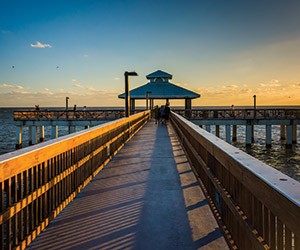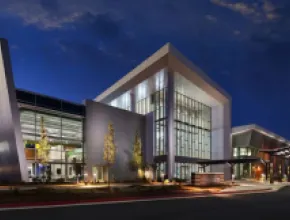The news came like a ray of sunshine: another record year for tourism in Florida. According to figures released in mid-February by VISIT FLORIDA, the state’s official tourism marketing corporation, 97.3 million visitors came to Florida in 2014, an increase of 3.9 percent over 2013. It’s the fourth consecutive record year for visitation to the Sunshine State, exceeding the previous high of 93.7 million in 2013.
And what’s good for tourism in Florida is good for meetings.
“Half the people who come to Florida stay in a hotel, and of that group, 20 percent are here for meetings, conventions or incentive travel,” says Paul Phipps, Visit Florida’s chief marketing officer. “They spend at a higher daily rate because they have multiple activities planned for large numbers of people. So business is good for us right now.”
It’s a sentiment echoed across the state.
“We’re seeing record-breaking attendance in shows coming to Orlando. We also saw record-breaking occupancy last year, with room demand at an all-time high,” says George Aguel, president and CEO of Visit Orlando. “In 2015, that trend is already off to a good start.”
Also trending upward is Orlando’s neighbor Kissimmee, whose 2015 pre-sell figures for large conventions were outstripping 2014 numbers, reports Tracy Ward, vice president of sales for Experience Kissimmee.
“The meetings business is coming back with a roar,” agrees Doug McLain, senior vice president of global sales for Discover the Palm Beaches. “We’re up 25 percent in bookings year-over-year.”
Even the numbers for sports groups have taken a jump, at least in Southwest Florida’s Charlotte County, frequent host of local and regional tournaments.
“In 2014, we had more events than in any year past, and already in 2015, we’ve surpassed the number of confirmed events we had in 2014,” says Sean Doherty, sales and sports marketing manager for the Charlotte Harbor VCB.
Sporting events also have contributed to growth in Ocala/Marion County, home to a number of equestrian competitions as well as the LPGA Coates Golf Championship. According to the county’s most recent figures, hotel occupancy rose 11.2 percent between fiscal years 2012 and 2014, with hotel revenues rising 19.5 percent over the same two-year span.
Meanwhile, the pace is on overdrive in the southern end of the state.
“Numbers continue to rise. We continue to raise new bars as far as rates and occupancies,” says Barry Moskowitz, vice president of sales for the Greater Miami CVB. “We’re seeing a lot more high-end corporate business, a direct result of the high-end product we’re building. You know the saying, ‘If you build it, they will come’? Sure enough, it’s happening.”
So when it comes to meetings and conventions, probably the biggest trend in Florida is growth, and in some cases, record growth.
What else is trending in Florida for group travel? We checked it out.
Shrinking Lead Times
Whether they started during the recession—when companies were reluctant to plan too far ahead—or if they have something to do with Florida itself, booking windows are short and in some cases, getting shorter.
“Short-term business is continuing to increase,” Moskowitz says. “Within six months, within three months, sometimes within the month. It seems to be more of a trend now, at least here in Miami.”
According to McLain of Discover the Palm Beaches, “it’s a Florida thing.”
“Florida is a safe, comfortable bet for companies that want to get back into getting their meetings together and reengage in training and corporate marketing meetings,” he says.
Phipps of VISIT FLORIDA agrees that the Sunshine State is uniquely positioned to handle short-term bookings.
“We can be more responsive on a shorter curve because we have 5,000 facilities with meeting space and 14 international airports,” he says. “If someone has a shorter booking window, they have more confidence that they can perform in Florida because of our excellent readiness and responsiveness.”
Other execs are seeing the longer lead times creep back in, however, including Pamela Watkins, director of sales for Visit South Walton.
“We’re getting RFPs for 2017 and 2018, and then we’re getting some for three months down the road,” she says. “Though the latter is for small groups.”
In Orlando, Aguel has noticed a similar mix.
“Some meetings are coming in on an extraordinarily short basis,” he says. “On the flip side, in a destination like ours where we get the large conventions and trade shows, they’re booking farther out because the availability of space is down. They have to make sure to lock in the dates they want and the space they need.”
PageBreak
Sellers Rule
Negotiating power has returned to the sellers’ side and ADRs are bouncing back from recession lows, many report.
“During the recession years, the supplier side started to give the house away in order to attract business. Today, that demand is back but with little or no increase in supply, so the seller has more control,” says Glenn Graham, director of conference sales for the St. Augustine, Ponte Vedra & the Beaches VCB.
And with that control have come higher ADRs in many cases.
“Our hotels are reporting that they’re doing well but need to keep getting those rates higher,” says Pamela Johnson, deputy director for the Beaches of Fort Myers & Sanibel. “The power has shifted back to the side of the hotels.”
Which can be a good thing, according to Visit Florida’s Phipps. With a statewide occupancy rate of 70 percent, he says the potential is strong for increasing ADRs, which has obvious benefit for suppliers but ultimately is good for business in general.
“When you have more pressure on ADR, there’s a much higher expectation of quality and performance, and I think that’s something Florida can really deliver on,” Phipps says. “The thing we try to communicate to the industry is that you constantly want to build planner confidence that you’re going to deliver on your promise.”
Some, though, see a downside to rising rates.
“It’s good for the economy, but it can put you at a competitive disadvantage if your hoteliers don’t budge,” says the Charlotte Harbor VCB’s Doherty. “A hotel might be hesitant to give a good rate for, say, 2016 because they don’t know what the ADR will be then. I think that will level out at some point.”
Bye, Bye Ballroom
Warm weather and product variety have made off-site venues perennial favorites in Florida, but more groups seem to be venturing forth from their hotels.
“I think planners are more willing to listen to creative breakout space ideas, like, ‘What if we put some of the meeting outdoors,’” says McLain of Discover the Palm Beaches. “I think the meetings architecture is changing.”
Visit Florida’s Phipps agrees. “As the industry has recovered, more planners are talking about doing this,” he says. “They’re not just booking conference areas, but the diverse venues the state offers.”
One of the strongest contenders in the category of diverse venues is Orlando, home of an ever-expanding universe of theme parks.
“We continue to see organizations take their groups off-site to the venues we have and use them for wonderful teambuilding experiences,” says Visit Orlando’s Aguel. “It isn’t just about having fun and riding some rides, but learning about the technology and the components behind the rides. A lot of groups break up and tour different facilities, then meet for lunch and talk about what they learned. As far as evening events, it’s a huge benefit when you think about a place with billion-dollar assets. You’ve got all that entertainment built in.”
Emerging Destinations
There’s more to the meetings landscape than South Florida, Orlando, Tampa, Jacksonville and other big cities with bigger convention centers. In fact, second- and third-tier destinations are flourishing in Florida.
“We really push destination diversity when we do tradeshows and represent the good product we have in all areas of the state,” Phipps says. “Certainly places like Sarasota, Fort Myers, Naples. You’re seeing a lot of growth in these areas.”
Lorah Steiner, director of tourism for the Charlotte Harbor VCB, says her destination has been growing little by little.
“I think more people are discovering us,” she says. “Here, you’re a big fish in a small pond. If you bring in a group that has 300 room nights, we’re going to be turning cartwheels for you.”
Budget considerations may also factor into the decision to choose a lower-profile area like Seminole County, set just north of Orlando.
“A lot of planners at our trade shows are looking for value,” notes Stephanie Hunicke, group sales manager for the Seminole County CVB. “We can offer them a reduced room rate. Yet we’re pretty central to the airports and to the beach.”
PageBreak
Less Talk, More Interaction
The emphasis now for many planners and their production teams is on creating a meeting “experience” vs. the traditional “sage on a stage” model of delivering information.
“I think the question is, ‘How can we connect with that attendee as an individual?’” says Experience Kissimmee’s Ward. “Content is a wonderful driver, but it’s not the only thing.”
A great majority of CVB reps point to social media and other tech tools that link to the individual, fundamentally changing the way meetings are now, and will be, conducted.
“Social media is huge with every meeting and conference I go to,” says Vanessa Zigich, meeting and group sales manager for Visit Sarasota County. “There’s always a hashtag and Twitter. There’s a competition for the conference to have more followers. So they post pictures, do a scavenger hunt or something.”
McLain points to a recent study indicating technology is actually changing our brains and shortening attention spans.
“That represents a challenge to the podium-style meeting we’ve grown accustomed to,” he says. “We’re seeing a more interactive environment. Group breakouts within a breakout, coming up with ideas and bringing them back to the speaker, things like that. It’s incumbent on planners to adapt to this new way of meeting.”
iConventions
So as technology and its attendant gadgetry have gone from fad to optional to must, how has the industry responded? The following article, “Technologically Speaking,” takes a more in-depth look at the way meetings have rebooted and what CVBs are doing to keep up. We’ll also check out tech innovations coming down the pike at hotels and resorts.






